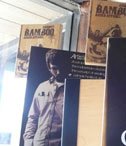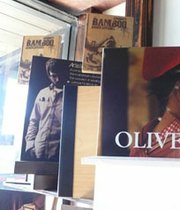AOSA Image Approaches Printing With Conservation, Quality
“Waste kills me. I hate it. It is so lame,” said Mike Hill, founder of Huntington Beach, Calif.–based AOSA Image, a printing company that specializes in environmentally friendly trade show booth components, point-of-purchase and point-of-sale signage, banners, and textile printing. At the moment, he is standing in his studio rubbing stain on pieces of wood destined to become store fixtures for Toms, the do-gooder shoe brand out of Santa Monica, Calif., that donates a pair of shoes to a needy child for every pair sold.
“If there is one thing I want to convey, it is that brands need to change the way they make display and promotional items,” he said. “If you are going to take the time to make something, do it smart. Choose quality materials, and instead of making 500 [displays], make 30 and use them in the right places. Make something that will last and that can be reused. Or get creative. Find cool ways to use things that could be considered waste and might end up in a landfill. Often, [reclaimed materials] make for better displays and a cooler project.”
AOSA was able to print on carpet remnants to outfit a booth for Livity, the Santa Monica–based apparel and accessories brand. For L*Space, the contemporary swimwear and coverup line from Irvine, Calif., AOSA used recycled plexiglass from a construction site as a backing for its POP signage. When the plexiglass ran out, L*Space’s signage was printed on aluminum.
Cutting down on consumption is a big focus for Hill, who is always looking for unique ways to incorporate others’ castoffs into AOSA projects for clients that include Hurley, Obey, Volcom, Oliver Peoples, Hippy Tree, Vans, Stance and Temple Bags. “Right now, I’m looking for leather scraps,” he said. “Don’t throw them away. Send them to me.”
The company, which was founded in 2006, uses only water-soluble inks and prints chiefly on recyclable materials such as wood, aluminum, bamboo, paper, natural and poly-blend fabrics and a specialty fabric made of 100 percent recycled post-consumer plastic bottles—making it an environmentally friendly printer and a rarity.
Hill, a surfer, said being a “green” business isn’t a marketing tactic but rather a byproduct of his own priorities. “If you walk into a printer and it is full of strong smells and fumes, that isn’t something I want to be around. Water-soluble inks don’t smell, so that’s what I use.”
And, he said, being environmentally friendly isn’t just a personal preference—for him, it is good business. Printers that use water-soluble inks tend to have better resolution and produce crisper images. Large-format ultra-violet printers, like those used by many traditional printers, can’t achieve the same level of crispness. Water-based inks that are used to print on fabric and garments don’t fade, said Ed Arnold, AOSA’s production manager.
More printers don’t opt for eco-friendly inks, Hill said, because water-based inks require more processes and auxiliary equipment per print job. “UV printers need only one machine [compared with] the three machines I need to print with [water-based] inks. [Other printers] say, ’Why buy three machines when you can buy one?’ But the quality is worth it.”
Hill, who has “Young Einstein” hair and a mad-scientist streak, takes an innovative approach to printing. He developed a new way to print on wood that saturates the ink deep into the wood—rendering the printed image on top more durable because it can withstand dings and scratches.
Being able to offer a high level of quality and innovation earns AOSA clients that may not necessarily be wooed by the company’s eco focus. That’s all the same to Hill, who acknowledges that AOSA’s services are unique and sometimes more expensive than traditional alternatives. “We are becoming more of a creative resource for brands. A lot of companies don’t have the resources to dedicate an art department to a specific project. We can do everything from brainstorming through execution,” he said.
The company, which has outgrown its current location, is prepping for an April move to a new 10,000-square-foot space in Huntington Beach. With the additional space will come additional services in AOSA’s repertoire. “We’re moving in a direction of offering more design services and partnering [with brands] on the inception of projects instead of just executing a job,” Hill said.
























